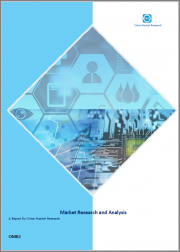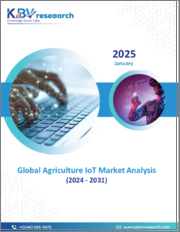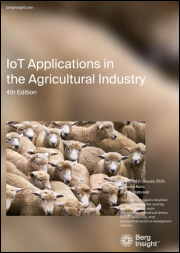
|
시장보고서
상품코드
1380280
세계의 농업용 사물인터넷(IoT) 시장(2023-2030년)Global Internet of Things (IoT) in Agriculture Market 2023-2030 |
||||||
세계 농업용 사물인터넷(IoT) 시장은 예측 기간(2023-2030년) 동안 연평균 11.5%의 성장률을 보일 것으로 예상됩니다. 인구 증가로 인한 식량 수요 증가, 정부 지원 확대, IoT 기술의 기술 발전 확대, 기후 조건의 급격한 변화 등이 농업 분야의 IoT 기술 수요를 촉진하고 있습니다.
부문별 전망
정밀농업과 토양 및 작물 모니터링 IoT 서비스 수요가 크게 확대될 전망
환경의 불확실성은 전 세계 농업 생산과 가축 손실의 가장 큰 원인 중 하나입니다. 미국 식량농업기구의 2008-2018년 조사에 따르면 가뭄, 폭풍, 홍수 등 재해가 농업 생산 손실의 가장 큰 원인입니다. 이들 재해 중 가뭄으로 인한 농업 생산 및 가축 손실의 34.0% 이상이 후진국 및 중저소득 국가에서 370억 달러 이상의 손실이 발생했으며, 홍수가 전체 농업 생산 및 가축 손실의 19.0%를 차지합니다. 농업에서 IoT 기술을 효과적으로 활용하면 농부들이 정밀 관개, 물 관리 시스템, 조기 경보, 기상 불확실성 등의 손실을 줄이거 나 제거 할 준비를 할 수 있습니다.
지역 전망
세계 농업용 사물인터넷(IoT) 시장은 북미(미국, 캐나다), 유럽(영국, 이탈리아, 스페인, 독일, 프랑스, 기타 유럽 지역), 아시아태평양(인도, 중국, 일본, 한국, 기타 아시아 지역), 기타 지역(중동 및 아프리카, 중남미) 등 지역별로 세분화됩니다. 이 중 북미는 2023-2032 OECD-FAO Agricultural Outlook에 따르면 북미가 세계 농업용 사물인터넷(IoT) 시장에서 가장 큰 비중을 차지하고 있으며, 전체 농업 생산량의 11%를 공급하고 있습니다. 그 주요 요인 중 하나는 전 세계 농업용지의 10%를 차지하고 있으며, 1인당 농지 이용 가능 면적이 전 세계 지역 중 가장 높다는 점입니다. 이 지역은 세계 수출의 12%를 차지하며, 이는 라틴아메리카, 동남아시아 다음으로 높은 수치입니다. 세계 농업 생산량에서 큰 비중을 차지할 뿐만 아니라, 이 지역은 유기농 식품 생산과 최적화된 생산에 주력하고 있습니다. 미국에서는 2022년 전체 비료 수입량이 22% 감소했지만, 생산 효율을 높이기 위해 많은 투자가 이루어지고 있습니다. 또한, 노동력 부족, 각 지역의 시장 리더의 존재감, 스마트 농업에 대한 정부의 지원 증가는 북미 지역 농업의 IoT 서비스 및 제품의 성장을 촉진하고 있습니다.
아시아태평양은 전 세계 농업용 사물인터넷(IoT) 시장에서 큰 성장세를 보일 것으로 예상됩니다.
아시아태평양은 전 세계 인구의 약 60%를 차지합니다. 인구 증가에 따라 이 지역의 식량 수요도 크게 증가하고 있습니다. 또한, 농업 부문은 중국, 인도 등 지역 경제에 큰 기여를 하고 있으며, 앞으로도 계속 성장할 것으로 예상됩니다. 인도 통계청(NSO)이 발표한 2021-22년 제3차 국민소득 사전추계에 따르면, 2021-22년 인도의 GVA(총 부가가치)에서 농업 및 관련 부문이 차지하는 비중은 현재 가격으로 약 18.6%에 달할 것으로 예상됩니다. 이 지역의 농업 부문은 최근 몇 년 동안 괄목할 만한 성장을 이뤘지만 가뭄 및 기타 자연재해, 토양 악화, 가격 변동, 불충분한 인프라 연계 등 심각한 도전에 직면해 있습니다. 이러한 문제를 극복하기 위해 이 지역의 민간 및 공공 부문은 스마트 농업에 대한 연구개발과 더 나은 정책 도입에 주력하고 있습니다. 예를 들어, 2023년 5월 인도정보기술대학교(IITB)와 인도원예연구소(IIHR)는 정밀 농업을 개선하기 위해 사물인터넷(IoT) 센서와 인공지능/머신러닝(AI/ML) 기술을 활용한 자동 온실 시스템을 개발할 것이라고 발표했습니다. 오토그로우(AutoGrow)라고 불리는 이 시스템은 실시간 데이터를 기반으로 작물 수확량과 자원 활용을 최적화하는 것을 목표로 하고 있습니다.
목차
제1장 보고서 개요
- 업계 현황 분석과 성장 가능성 전망
- 조사 방법과 툴
- 시장 내역
- 부문별
- 지역별
제2장 시장 개요와 인사이트
- 조사 범위
- 애널리스트의 인사이트와 현재 시장 동향
- 주요 조사 결과
- 추천사항
- 결론
제3장 경쟁 상황
- 주요 기업 분석
- AGCO Corporation
- 개요
- 재무 분석
- SWOT 분석
- 최근의 동향
- CropX, Inc.
- 기업 개요
- 재무 분석
- SWOT 분석
- 최근의 동향
- John Deere GmbH & Co. KG.
- 개요
- 재무 분석
- SWOT 분석
- 최근의 동향
- Topcon Positioning Systems, Inc.
- 개요
- 재무 분석
- SWOT 분석
- 최근의 동향
- 주요 전략 분석
제4장 시장 세분화
- 농업용 사물인터넷(IoT) 세계 시장 : 유형별
- 하드웨어
- 소프트웨어
- 농업용 사물인터넷(IoT) 세계 시장 : 농장 규모별
- 소규모
- 중규모
- 대규모
- 농업용 사물인터넷(IoT) 세계 시장 : 용도별
- 정밀 농업
- 가축 모니터링
- 수산양식 관리
- 온실 자동화
- 토양과 작물 모니터링
제5장 지역 분석
- 북미
- 미국
- 캐나다
- 유럽
- 영국
- 독일
- 이탈리아
- 스페인
- 프랑스
- 기타 유럽
- 아시아태평양
- 중국
- 인도
- 일본
- 한국
- 기타 아시아태평양
- 세계 기타 지역
제6장 기업 개요
- AG Leader Technology, Inc.
- AgJunction LLC(a subsidiary of Kubota Corporation)
- Arable Labs, Inc.
- Ceres Imaging, Inc.
- Climate LLC
- Cropin Technology Solutions Pvt Ltd
- Farmer Edge Inc.
- FarmWise Labs, Inc.
- Harvest CROO Robotics LLC.
- iFoodDecisionSciences, Inc.
- iOTFarm, Inc.
- Kverneland AS
- Raven Industries, Inc.
- TeeJet Technologies(a subsidiary of Spraying Systems Co.)
- Trimble Inc.
Title: Global IoT in Agriculture Market Size, Share & Trends Analysis Report by Type (Hardware and Software), by Farm size (Small, Medium, and large size farm), and by Application (For Precision Agriculture, Livestock Monitoring, Aquaculture Management, Greenhouse Automation and Soil and Crop Monitoring),Forecast Period (2023-2030).
The global IoT in the agriculture market is anticipated to grow at a CAGR of 11.5% during the Forecast Period (2023-2030). Growing demand for food due to the growing population, increasing government support, growing technological advancements in IoT technology, and rapidly changing climate conditions are driving demand for IoT technology in the agriculture sector.
Segmental Outlook
The global IoT in the agriculture market is segmented by Type, farm size, and applications. Based on type the market is sub-segmented into hardware-based IoT services and software-based IoT services. The market is sub-segmented into small, medium, and large farms based on farm size. Based on application the market is sub-segmented for precision agriculture, livestock monitoring, aquaculture management, greenhouse automation, and soil and crop monitoring uses. The demand for livestock monitoring-based IoT services is expected to grow considerably. According to the Food and Agricultural Organization of the United States, crop and livestock diseases and infections caused approximately 9.0% of total loss between the years 2008 to 2018. The adoption of IoT technology can help to reduce livestock loss. It can be used in remote monitoring of livestock health such as temperature, and activity levels, to get early warnings for potential disease and other health problems by monitoring air quality in livestock barns, precision feeding, and animal tracking among others.
The Demand for Precision Agriculture and Soil and Crop Monitoring IoT Services Is Expected to Grow Considerably
Environmental uncertainties are one of the biggest reasons for global agriculture production and livestock losses. According to a 2008 to 2018 study of Food and Agriculture organizations in the United States, disasters such as drought, storms, and floods are the biggest reasons for agricultural production loss. Out of these disasters, over 34.0% of agricultural production and livestock loss is caused by draught alone, costing over $37 billion loss in least developed countries and low- and middle-income countries followed by floods which accounted for 19.0% of total agricultural production and livestock loss. Effective usage of IoT technology in agriculture can help farmers prepare to reduce or eliminate losses such as precision irrigation, water management systems, early warning, or weather uncertainties.
Regional Outlook
The global IoT in agriculture market is further segmented based on geography including North America (the US, and Canada), Europe (UK, Italy, Spain, Germany, France, and the Rest of Europe), Asia-Pacific (India, China, Japan, South Korea, and Rest of Asia), and the Rest of the World (the Middle East & Africa, and Latin America). Among these, North America holds a prominent share in global IoT in the agriculture market. According to the 2023-2032 OECD-FAO Agricultural Outlook, North America provides 11% of total agricultural output. One of the major factors is the country accounts for 10% of the land used for agriculture globally and the availability of agricultural land per capita is highest among all regions. The region accounts for 12% of global exports, which is the highest after Latin America and Southeast Asia. Apart from a significant presence in global agricultural output, the region is also focusing on more organic food production and optimized production. Although the overall fertilizer import in the US has declined by 22% in 2022, the country has seen significant investments to improve production efficiency. Also, the shortage of labor force, significant presence of market leaders in the regions, and growing government support for smart agriculture are driving growth for IoT services and products in agriculture in the North American region.
The Asia-Pacific Region is Expected to Grow Significantly in the Global IoT in Agriculture Market.
The Asia-Pacific region accounts for approximately 60% of the global population. With the growing population, regional food demand is also growing significantly. Additionally, the agricultural sector is one of the major contributors to regional economies such as China and India and is expected to grow. As per the third Advance Estimates of National Income, 2021-22 released by the National Statistical Office (NSO) of India, Ministry of Statistics & Programme Implementation, the agriculture, and allied sectors contributed approximately 18.6 % of India's GVA (Gross value added) at current prices during 2021-22. Although the regional agricultural sector has seen significant growth in recent years, it is also facing severe challenges such as drought and other natural calamities, soil degradation, volatile prices, and inadequate infrastructure linkage among others. To overcome these challenges the private and public sector in the region is focusing on smart agriculture by focusing on research and development and introducing better policies. For instance, in May 2023, The Indian Institute of Information Technology Bangalore (IITB) and the Indian Institute of Horticultural Research (IIHR) announced to be developing an automated greenhouse system using Internet of Things (IoT) sensors and Artificial Intelligence/Machine Learning (AI/ML) techniques to improve precision agriculture. The system, called AutoGrow, aims to optimize crop yield and resource usage based on real-time data.
Market Players Outlook
The major companies serving the IoT in the agriculture market include: AGCO Corporation, CropX, Inc., John Deere GmbH & Co. KG., Topcon Positioning Systems, AG Leader Technology, Inc. Arable Labs, Inc. among others. The companies are majorly focusing on research and development and new product launches to stay competitive in the market. For instance, in March 2023, Mahindra's AgTech business, Krish-e, launched the Krish-e Smart Kit (KSK), an IoT-based device that provides equipment owners with real-time data on their tractors and farm equipment, such as GPS location, fuel consumption, and engine performance. The data can be accessed through a smartphone app.
The Report Covers:
- Market value data analysis of 2022 and forecast to 2030.
- Annualized market revenues ($ million) for each market segment.
- Country-wise analysis of major geographical regions.
- Key companies operating in the global IoT in the agriculture market. Based on the availability of data, information related to new product launches, and relevant news is also available in the report.
- Analysis of business strategies by identifying the key market segments positioned for strong growth in the future.
- Analysis of market-entry and market expansion strategies.
- Competitive strategies by identifying 'who-stands-where' in the market.
Table of Contents
1. Report Summary
- Current Industry Analysis and Growth Potential Outlook
- 1.1. Research Methods and Tools
- 1.2. Market Breakdown
- 1.2.1. By Segments
- 1.2.2. By Region
2. Market Overview and Insights
- 2.1. Scope of the Report
- 2.2. Analyst Insight & Current Market Trends
- 2.2.1. Key Findings
- 2.2.2. Recommendations
- 2.2.3. Conclusion
3. Competitive Landscape
- 3.1. Key Company Analysis
- 3.2. AGCO Corporation
- 3.2.1. Overview
- 3.2.2. Financial Analysis
- 3.2.3. SWOT Analysis
- 3.2.4. Recent Developments
- 3.3. CropX, Inc.
- 3.3.1. Overview
- 3.3.2. Financial Analysis
- 3.3.3. SWOT Analysis
- 3.3.4. Recent Developments
- 3.4. John Deere GmbH & Co. KG.
- 3.4.1. Overview
- 3.4.2. Financial Analysis
- 3.4.3. SWOT Analysis
- 3.4.4. Recent Developments
- 3.5. Topcon Positioning Systems, Inc.
- 3.5.1. Overview
- 3.5.2. Financial Analysis
- 3.5.3. SWOT Analysis
- 3.5.4. Recent Developments
- 3.6. Key Strategy Analysis
4. Market Segmentation
- 4.1. Global Internet of Things (IoT) in agriculture Market by type
- 4.1.1. Hardware
- 4.1.2. software
- 4.2. Global Internet of Things (IoT) in agriculture Market by farm size
- 4.2.1. small
- 4.2.2. medium
- 4.2.3. large
- 4.3. Global Internet of Things (IoT) in agriculture Market by application
- 4.3.1. Precision Agriculture
- 4.3.2. Livestock Monitoring
- 4.3.3. Aquaculture Management
- 4.3.4. Greenhouse Automation
- 4.3.5. Soil and Crop Monitoring
5. Regional Analysis
- 5.1. North America
- 5.1.1. United States
- 5.1.2. Canada
- 5.2. Europe
- 5.2.1. UK
- 5.2.2. Germany
- 5.2.3. Italy
- 5.2.4. Spain
- 5.2.5. France
- 5.2.6. Rest of Europe
- 5.3. Asia-Pacific
- 5.3.1. China
- 5.3.2. India
- 5.3.3. Japan
- 5.3.4. South Korea
- 5.3.5. Rest of Asia-Pacific
- 5.4. Rest of the World
6. Company Profiles
- 6.1. AG Leader Technology, Inc.
- 6.2. AgJunction LLC (a subsidiary of Kubota Corporation)
- 6.3. Arable Labs, Inc.
- 6.4. Ceres Imaging, Inc.
- 6.5. Climate LLC
- 6.6. Cropin Technology Solutions Pvt Ltd
- 6.7. Farmer Edge Inc.
- 6.8. FarmWise Labs, Inc.
- 6.9. Harvest CROO Robotics LLC.
- 6.10. iFoodDecisionSciences, Inc.
- 6.11. iOTFarm, Inc.
- 6.12. Kverneland AS
- 6.13. Raven Industries, Inc.
- 6.14. TeeJet Technologies (a subsidiary of Spraying Systems Co.)
- 6.15. Trimble Inc.



















